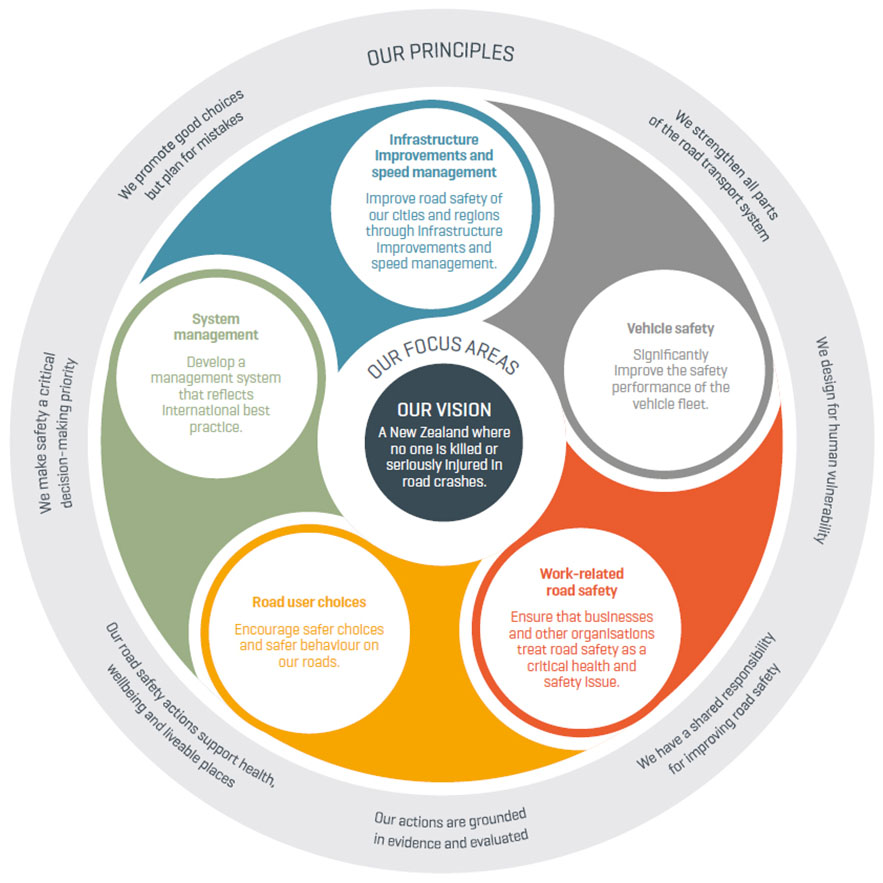This document, entitled Part 5 Traffic control devices for general use – between intersections is part of a suite of guidelines within the Traffic control devices manual (TCD manual) prepared by Waka Kotahi NZ Transport Agency. The document is intended to help provide guidance and indicate best practice on the use of traffic control devices related to guiding road users around the road network. In particular, it provides specifications, form, layout and dimensions of traffic control devices for use in New Zealand, which are mandated by legislation, such as the Land Transport Rule: Traffic control devices.
It outlines the legal framework and responsibilities for the design and installation of traffic control devices, including the general principles behind their use at the time the document has been drafted. It should not be used in substitution for professional advice as to compliance with relevant central and local government requirements. Specific terminology is used within the document to determine whether an aspect or statement made is a requirement under law or good practice; the terms are:
The Land Transport Rule: Traffic control devices 2004 (TCD Rule), specifies that:
Traffic control device
(a) means a device used on a road for the purpose of traffic control; and
(b) includes any:
(i) sign, signal, or notice; or
(ii) traffic calming device; or
(iii) marking or road surface treatment; but
(c) does not include roadway art installed in accordance with 5.6(1) [of the TCD Rule].
Unless explicitly stated otherwise, all markings described in this Manual should be white.
When identifying the signs used in this Manual, the sign codes from Schedule 1 of the TCD Rule have been used. Signs codes that do not discriminate between a left or right facing sign symbol have the suffix (L) or (R) added to the end of the sign code; where (L) corresponds to the left facing sign symbol and (R) corresponds to the right facing sign symbol. Some signs specified in this Manual are modified versions of an existing sign; these signs have the suffix (M) added to the end of the sign code.
Further definitions of terms used within Part 5 are provided in the TCD manual definitions list.
The document seeks to incorporate links to a number of appropriate policies, standards and guidelines. It forms part of the Traffic control devices manual, which provides best industry practice for the use of traffic control devices. This document should be read and applied in conjunction with legislation, standards, and industry best practice guidance including, but not limited to, the following:
Where road markings and signs relate to specific types of roads users, relevant comment has been included and reference made to other parts of the TCD manual as appropriate.
This manual provides guidance to traffic and transport practitioners on the use and application of traffic control devices for general use between intersections. The subjects covered are:
This manual does not cover roadway art.
For guidance on roadway art, see the Handbook for Tactical Urbanism in Aotearoa
This manual provides rules, standards and guidance on the use and application of traffic control devices for general use between intersections. However, practitioners should always apply sound engineering judgement in the use and installation of traffic signs and markings to ensure they will be effective at any particular site. For instance, the road geometry at a site may require some modification to the picture or message on a sign face to clearly convey an important message such as the shape of the road, or a sign may have to be installed at a more appropriate location than the location specified in this document. In such instances, engineering judgement should be applied and any departures from best practice should be documented with the reasons.
In addition, although Part 5 of the manual specifically covers the use of traffic control devices between intersections and Part 4 of the manual covers the use of traffic control devices for intersections, if a portion of the road network is at an intersection but a particular network feature functions as being between intersections (and vice versa), engineering judgement should be applied to determine the most appropriate TCD measures to apply.
Whilst this manual provides guidance it should be noted however, that good road markings, delineation and signs will not overcome fundamental deficiencies in the road (e.g. insufficient road width or worn road surfaces).
The New Zealand Government released its Road to Zero: road safety strategy in December 2019. Road to Zero is a national strategy to guide improvements in road safety from 2020 to 2030 with the vision of a New Zealand where no one is killed or seriously injured in road crashes. To measure success, the Road to Zero strategy has set a target of a 40 percent reduction in deaths and serious injuries by 2030 with five key action areas of:
To support the Road to Zero strategy, the safe system approach to road safety has been adopted.
The safe system follows four key principles:
In addition to the four key principles, the safe system approach also has four key cornerstones (illustrated in Figure 1‑1). These are:
Figure 1‑1: Road to Zero focus areas
View larger image [JPG, 148 KB]
In relation to the use of traffic control devices, road controlling authorities (RCAs) should pay particular attention to providing safe roads and roadsides that are predictable and forgiving of mistakes.
To determine the treatment philosophy and types of tools that can be used, refer to the:
The One Network Road Classification (ONRC) involves categorising roads based on the functions they perform as part of an integrated national network. The classification will help local government and Waka Kotahi to plan, invest in, maintain and operate the road network in a more strategic, consistent and affordable way throughout the country.
Refer to Appendix D of this manual for descriptions of the functional classification of the one network road classification.
Appendix D: One Network Road functional classification summary